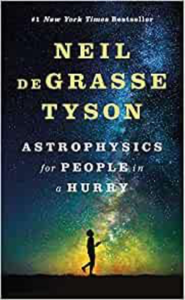
Astrophysics for People in a Hurry
By Neil deGrasse Tyson
244 pages
Published in 2017 by W.W. Norton & Co.
“I’m in a hurry,” I thought.
“Astrophysics? I’ve been trying to teach myself physics – Newtonian physics, relativity, quantum mechanics – for decades, with only marginal success. Maybe this book will give me another foothold on the subject. And maybe, as a bonus, I could develop an opinion about the Big Bang theory and black holes.”
I’m halfway through the book as I write this. I’m reading and listening to it, as I’ve become accustomed to doing. Professor Tyson himself does the reading. And he does a nice job of it. Warm, friendly, funny.
All the big issues are here: space, time, how the universe began, how we fit into it.
What I like about it: Pretty much everything so far. I especially like that the chapters are broken into small, digestible pieces.
What I don’t like about it: Despite his clarity, Tyson leaves me behind in almost every chapter. I’m getting the bigger points, but I’m still in the fog on the trickier stuff. If I’m going to really learn from this book, I’m probably going to have to read it more than once. But that’s a price I’m willing to pay.
Critical Reception
* “Tyson is a master of streamlining and simplification… taking mind-bogglingly complex ideas, stripping them down to their nuts and bolts, padding them with colorful allegories and dorky jokes, and making them accessible to the layperson.” (Salon)
* “Tyson manifests science brilliantly… [his] insights are valuable for any leader, teacher, scientist, or educator.” (Forbes)
* “The book is not quite astrophysics for dummies; while it is simplified, it is not simple. It is more a collection of the best and most thrilling moments; astrophysics’ greatest hits.” (The Guardian)
* “DeGrasse Tyson has a talent for making very complicated concepts seem simple, and the amount of content squeezed into one short volume is impressive. He certainly knows his stuff. It takes no time at all to romp through a chapter as the book is written with humour and his descriptions verge on the poetic.” (Chemistry World)
 MarkFord
MarkFord